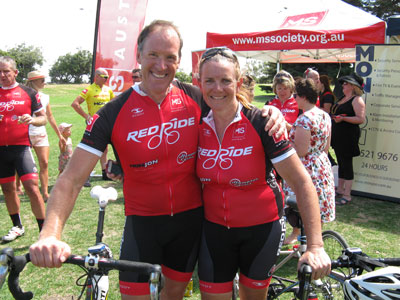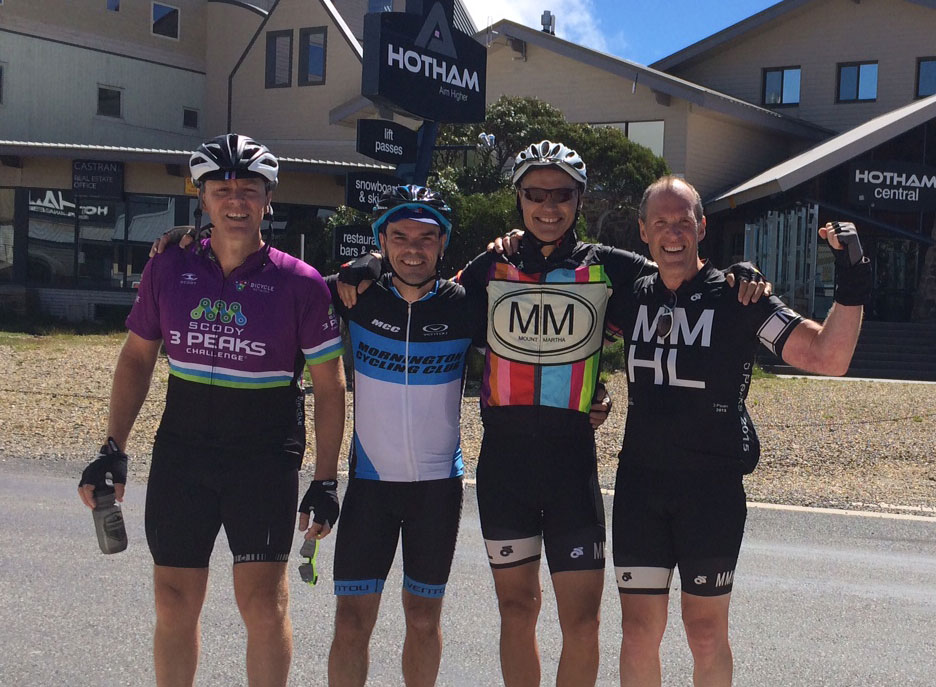An MS diagnosis hasn’t stopped Steve van Ruyven from reaching some lofty heights on a bike. He tells Melissa Heagney how getting back on two wheels has given him a new life.
Name
Steve van Ruyven
Age
50
Lives
Mount Eliza
Job
Managing himself
WHEN he was in Grade 6 at St Joseph’s Primary School in Melbourne’s South Eastern suburbs, it wasn’t unusual to see an 11-year-old Steve van Ruyven “hooning” around on his bike with mates. They’d often head to the beach around Black Rock where he grew up, checking out the scene. Riding his bike was a great way to connect with friends (and to earn money by delivering newspapers on the side).
Fast forward almost 40 years and little has changed. Van Ruyven is still hooning around on his bike with friends, but the background has shifted from the beach to the hills across Victoria. Riding with his mates, van Ruyven says he can almost fly across the bitumen or trails, taking in the sights around Mornington (near where he lives) before stopping for a well-earned coffee break to shoot the breeze.
“The social side of it is so uplifting it makes life a lot better,” van Ruyven says with a smile.
While there’s a social side to his riding, van Ruyven is anything but a casual rider. He recently took part in Bicycle Network’s Peaks Challenge Falls Creek (and another hilly challenge, the 7 Peaks).
While it may sound merely tough to some riders, those close to van Ruyven know that, for him, riding the peaks is somewhat of a miracle. That’s because in 1996 at age 32, van Ruyven was diagnosed with MS. At the time he was working as a Regional Manager at a big company with a young family and responsibilities.
“I was sitting at my computer at my desk one day and I just started to feel dizzy—disoriented—and I went to the doctor and he told me I had an inner ear infection. After that I started getting other strange symptoms—I was walking really slowly, the whole left side of my body became numb which was really weird,” van Ruyven explains.
“So I kept going back to the doctor and he said: ‘really, I can’t find anything wrong with you’.”
Van Ruyven says his symptoms started to become worse over the next few months.
“My biggest problem was fatigue—I guess it’s similar to something you have with glandular fever or chronic fatigue syndrome,” he says. “I had responsibilities so I felt I was letting my work colleagues down as I couldn’t do much and I was letting my family down because I couldn’t do things with my kids.”
Since the doctor couldn’t explain his symptoms, van Ruyven says he assumed it was nothing serious. “I felt like a hypochondriac,” he says.
But when van Ruyven discovered he couldn’t use his fingers to type at his computer, he went back to the doctor. The doctor sent him to a neurologist. He was almost immediately diagnosed with MS. Though it took six months of strange symptoms to discover what had been going on, in one short moment his life changed forever.
“It was a bit of a relief really finding out what was wrong. I knew nothing about MS, so after I saw the neurologist I called my sister-in-law who’s a nurse on the way home from the neurologist (to find out more).”
It was a tough time for van Ruyven who had to retire aged 33 in order to deal with some of his debilitating symptoms and ensure he got the rest his body needed.
It wasn’t until eight years later, when his son was 11, that van Ruyven’s life would change again—this time in a very positive way. His son wanted to go for a bike ride, so he decided he’d like to go riding with him.
“I dragged my bike out of the shed and I found I could do a little bit of riding with my son,” he says.
Those short rides grew to longer ones on bike trails in and around Mordialloc with friends. Van Ruyven bought his first road bike in 2010 “not knowing if I could ride the thing,” he says. “I do have balance concerns.”
Despite these concerns he soon found he could not only ride a road bike, but do quite a distance on it. A few years later, building up his fitness, van Ruyven decided to take on his first cycling challenge, the MS Cycle Melbourne—a 50km ride to raise awareness and funds for MS Australia.
 With the first challenge under his belt, he wanted to conquer the next mountain—literally. So he took on the 7 Peaks.
With the first challenge under his belt, he wanted to conquer the next mountain—literally. So he took on the 7 Peaks.
“I did the 7 Peaks quite by accident. I started out with one with a friend and ended up doing six others,” he says with a laugh.
He followed up with the 7 Peaks again this year, and not to be outdone, also rode Bicycle Network’s Peaks Challenge Falls Creek in March. Van Ruyven says these challenge rides taught him valuable lessons about his ability on a bike and his limits off it.
“I can’t train every day; I have to train differently to everybody else,” van Ruyven says.
“The people I (went) on the Peaks Challenge with, they’re the elite types and used to get me up at 5.30am to ride. I can’t do that; it has to fit in with my rest routine,” he explains.
He says he knows if he’s been pushing himself too hard because he starts to get strange symptoms.
“The signal is that I get a zapping down my neck like an electric shock,” he says.
When preparing for a ride like Peaks Challenge, van Ruyven says he had to come up with his own riding routine—there was little literature on riding at this level with MS.
“I had to discover these things for myself, and learn that honouring my rest routine is the way to go,” he says.
Another important lesson van Ruyven learned was to balance rest with energy and fluid intake to ensure attacks from over exerting himself are kept in check. As with many elite cyclists, diet and hydration are the keys to making sure van Ruyven stays in tip-top shape (and avoids the dreaded bonk). While “the bonk” can have drastic consequences for many cyclists, the outcome can have very serious consequences for van Ruyven and lead to more MS symptom attacks.
“It’s (the bonk) happened to me and it’s just horrible—it is the stress you’re putting your body under,” he says. “Now I’m using gels more frequently than the others I ride with. I usually have a gel or a bar every hour and I do drink a lot of fluid. I carry two 750ml bottles of drink on my bike so I’m keeping my fluids and energy up.”
After riding these types of events it can take days—sometimes even months—to recover. But he says the social side of being on a bike makes the longer recoveries all worthwhile. So too, the freedom it gives him despite his mobility issues.
“Cycling hasn’t helped my MS, but it has made my legs strong. I find walking a struggle, for some reason it’s really hard on me, but pedalling a bike is not as hard as walking.”
It’s also the feeling of fitting in with the crowd.
“With my lycra on, my helmet on, my sunnies on, I look like anyone else—I don’t look like I have MS.”
While he started riding again with his son, he says his kids aren’t as into bike riding as they once were.
“My son (now 18) packed it in once he discovered girls—and my daughter (21), she rides with me occasionally,” he says with a laugh.
Despite the fatigue and the rest needed to recover from challenge rides, van Ruyven is still signing up for events. Next up is the MS Cycle Melbourne on 19 April. He’ll be riding with his partner, Lianna.
“She’s not a regular cyclist but it’s only 50km and it’s a really social day—a nice pedal around Melbourne,” he says.
His mates, he says, will be coming along for the ride, too.
Steve van Ruyven is an MS Ambassador
Ride On content is editorially independent, but is supported financially by members of Bicycle Network. If you enjoy our articles and want to support the future publication of high-quality content, please consider helping out by becoming a member.


I also ride and have MS. My choice 5 years ago was an ebike and this literally gave me my legs back. I can certainly identify with Steve about being able to ride better than walk. Great article.